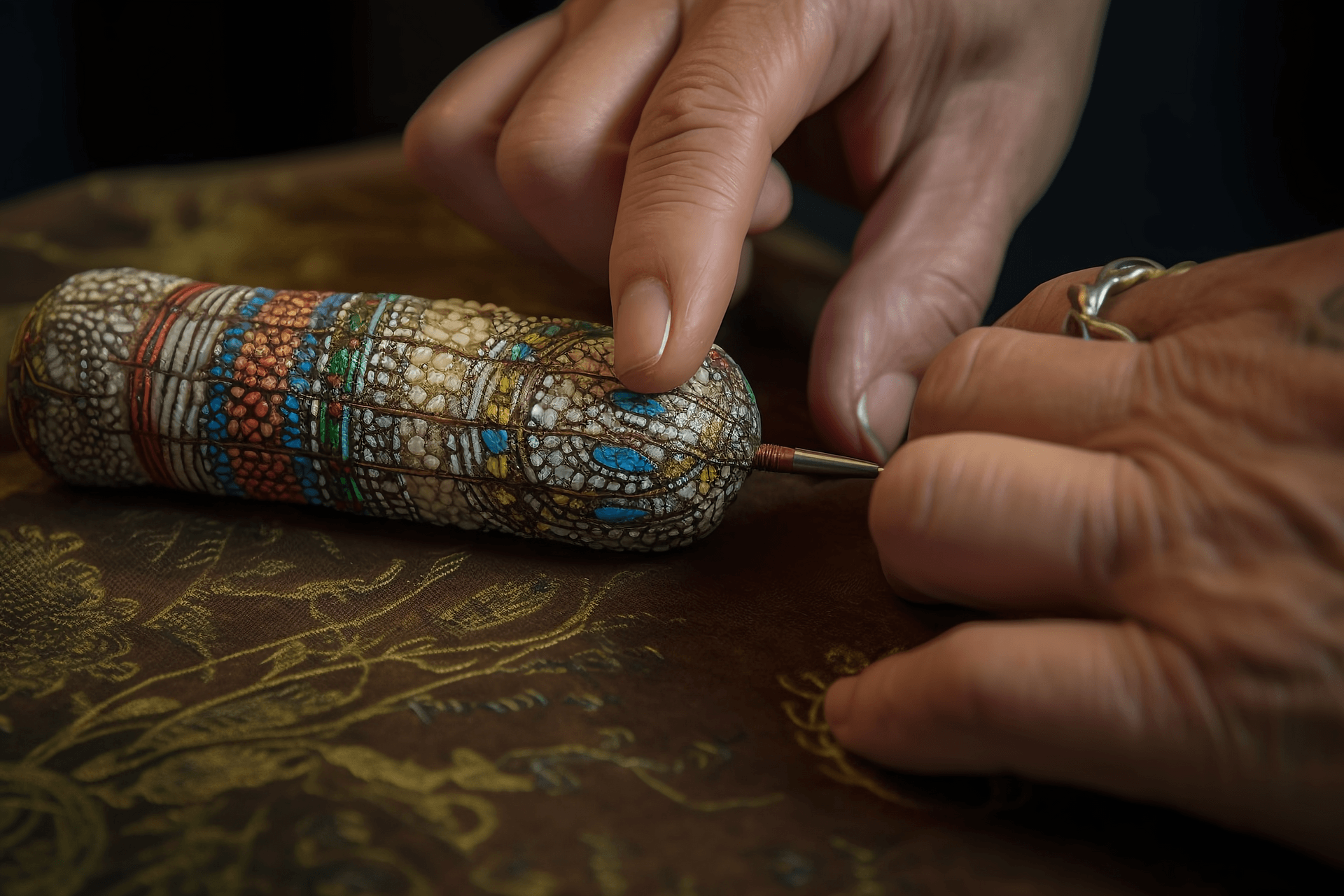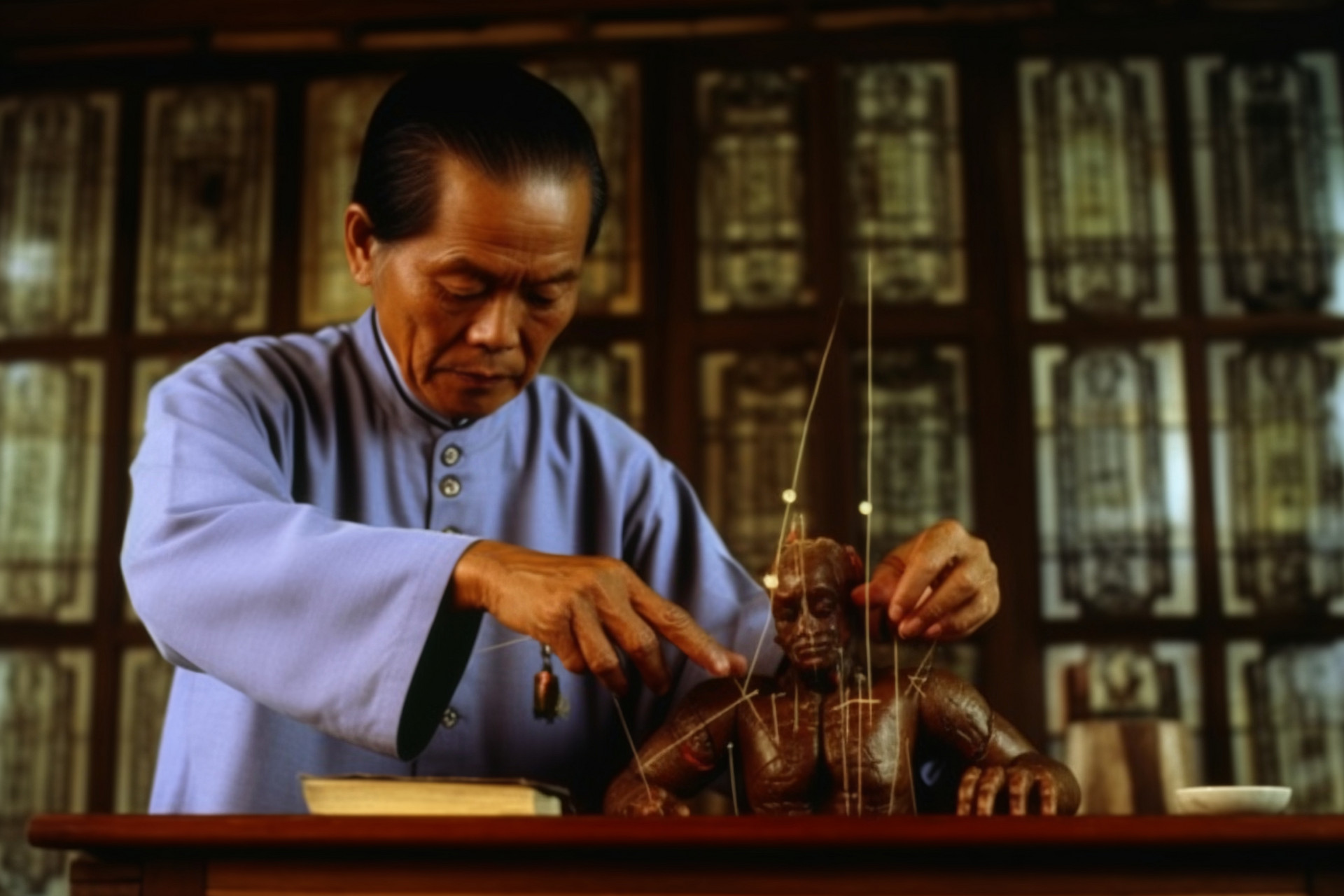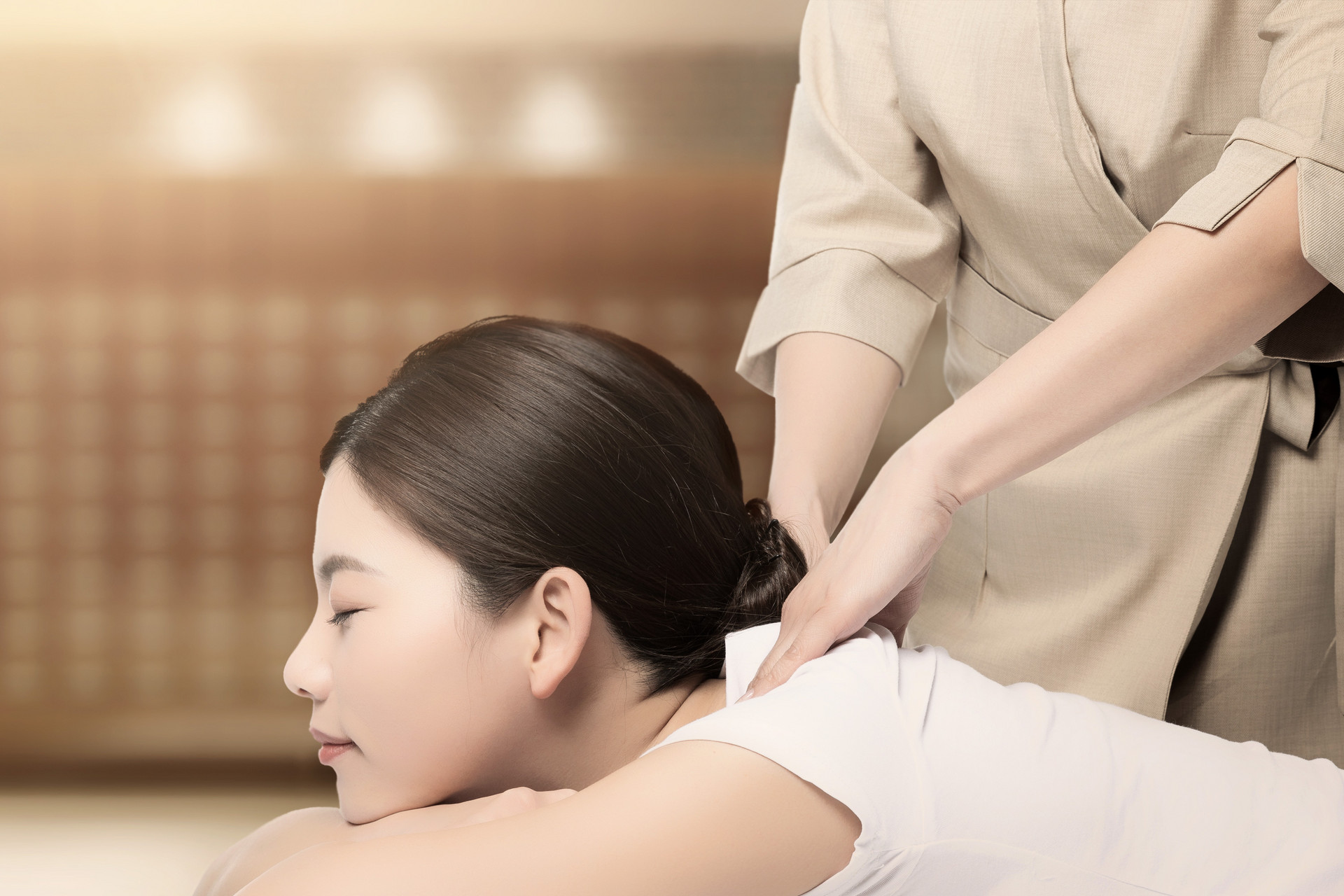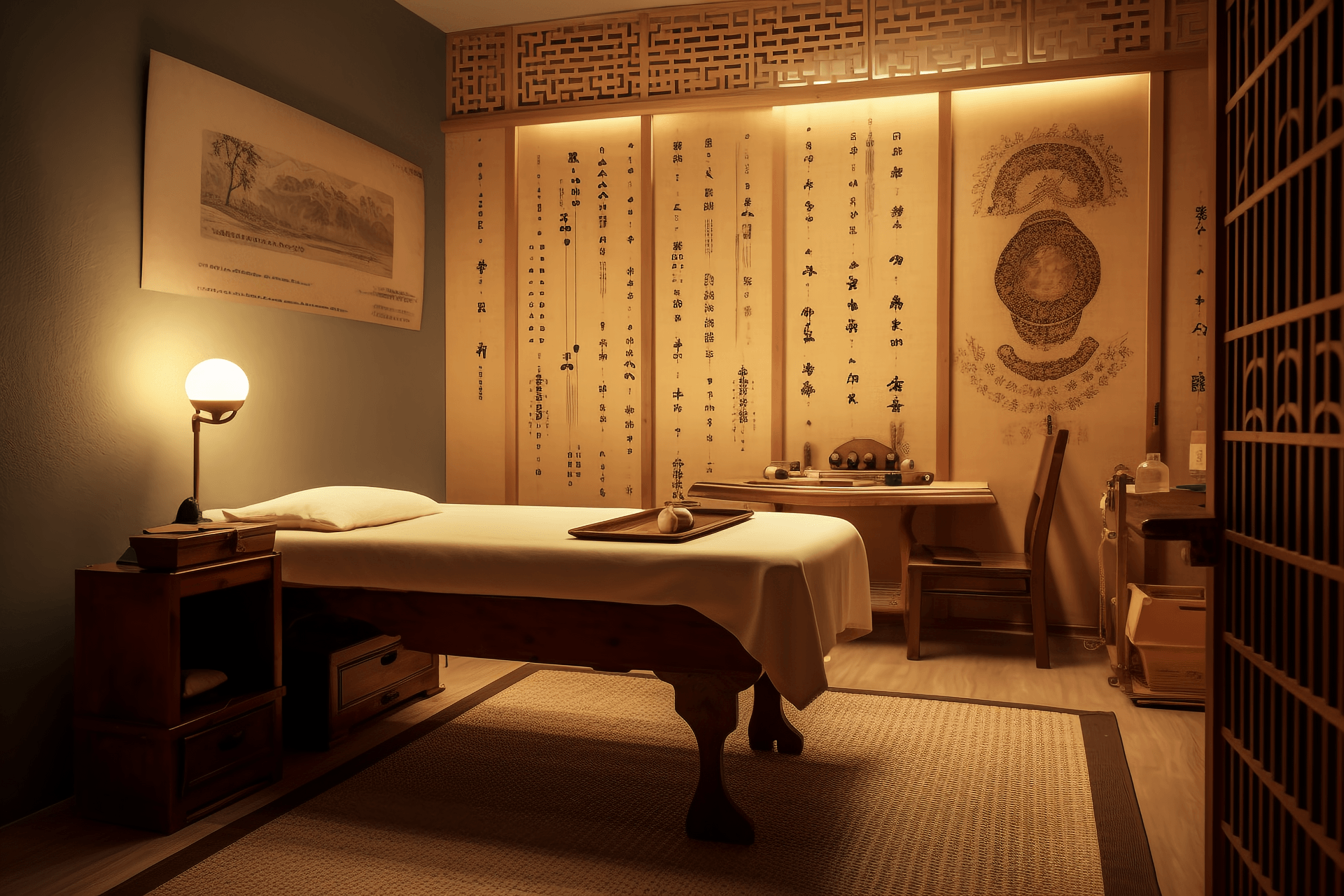Foot needle therapy is a method of treating systemic diseases by using acupuncture, moxibustion, or external application of medication on specific acupoints on the feet. The Yellow Emperor's Inner Canon states, "Yang Qi starts from the surface of the five toes, while Yin Qi starts from the inside of the toes." The foot three yin meridians start from the feet, and the foot three yang meridians end at the feet. The foot yangming meridian ends at the outer side of the second toe and its collateral meridians enter the big toe and the third toe. The foot taiyang meridian passes through the red and white flesh junction on the outer side of the foot and ends at the side of the toenail of the little toe. The foot shaoyang meridian runs on the outer side of the foot dorsum and ends at the outer side of the fourth toe, with its collateral meridians slanting into the big toe. The foot three yin meridians are connected with the corresponding yang meridians on the surface of the body and start from the inner side of the big toe, the outer ankle, and the sole of the foot, and ascend to various parts such as the red and white flesh junction on the inner side of the foot, the foot dorsum, and the sole of the foot. The hand and foot three yin and yang meridians are connected through the superficial and deep meridians and have connections with the corresponding meridians on the hands and feet. The extraordinary meridians, Yangwei meridian, and Yin and Yang Qiao meridians start from the feet. This indicates that the feet are connected to the body's organs and tissues through the meridians. At the same time, the feet are also the root and main location of the foot three yin and yang meridians, and the acupoints of these meridians are mostly distributed on the feet. These acupoints can be used to treat diseases in distant parts of the body such as the head, face, sense organs, internal organs, and trunk. Through long-term observation, it has been found that there is a relationship between the feet and the whole body. It is like a fetus lying flat on the palm of the foot, with the head located at the heel, the buttocks facing the toes, and the five viscera and six bowels distributed in the middle of the foot. Based on this rule, on the basis of meridians and acupoints theory, some new acupoints have been determined on the feet. By stimulating these acupoints, the body's meridian Qi can be activated to adjust the connection between organs and tissues, achieving the goal of tonifying the body and dispelling pathogenic factors and treating diseases.
[Operations]
I. Localization and Indications of Acupoints
To facilitate acupoint selection, the foot is measured in inches according to bone landmarks. The following method is used: The midpoint of the back edge of the heel is connected to the line between the second and third toes and folded into ten inches. This line is the midline. The highest point of the inner and outer ankle and the vertical line on the inner and outer edge of the sole of the foot are folded into three inches. The widest distance of the heel is three inches. The intervals between the toes on the sole of the foot and the line connecting the back edge of the heel parallel to the midline are each one inch.
Basic Foot Acupoints
1. Sole of the Foot
(1) Head Acupoint: Located 1 inch in front of the midpoint of the red and white flesh junction below the heel. Indications: Headache, toothache.
(2) Nose Acupoint: 1 inch in front of the head acupoint, vertically aligned with the heel and the head acupoint. Indications: Acute and chronic rhinitis.
(3) Eye Acupoint: 0.6 inch outside the nose acupoint. Indications: Acute and chronic eye diseases.
(4) Ear Acupoint: 1.2 inches outside the nose acupoint. Indications: Tinnitus, hearing loss.
(5) Mouth Acupoint: 1 inch in front of the nose acupoint, vertically aligned with the nose acupoint. Indications: Toothache, sore throat, tonsillitis.
(6) Throat Acupoint: 0.6 inch in front of the mouth acupoint, vertically aligned with the mouth acupoint. Indications: Fever, pharyngitis, tonsillitis, cold.
(7) Regeneration Acupoint: 0.6 inch in front of the throat acupoint, vertically aligned with the throat acupoint. Indications: Head and spinal cord pain, can relieve pain and improve symptoms, and the stimulation can reach both sides of the Achilles tendon.
(8) Heart Acupoint: 0.5 inch in front of the regeneration acupoint, vertically aligned with the regeneration acupoint. Indications: Hypertension, heart failure, laryngitis, glossitis, insomnia, and vivid dreaming.
(9) Lung Acupoint: 1 inch beside the heart acupoint and 0.1 inch posteriorly. Indications: Cough, asthma, chest pain.
(10) Sleep Acupoint: 0.6 inch in front of the heart acupoint, vertically aligned with the heart acupoint. Indications: Neurasthenia, schizophrenia, hysteria.
(11) Stomach Acupoint: 0.8 inch in front of the sleep acupoint, vertically aligned with the sleep acupoint. Indications: Stomach pain, vomiting, indigestion.
(12) Liver Acupoint: 1.2 inches inside the stomach acupoint. Indications: Chronic hepatitis, cholecystitis, eye diseases, intercostal neuralgia.
(13) Spleen Acupoint: 1.2 inches outside the stomach acupoint. Indications: Indigestion, urinary retention, blood disorders.
(14) Gallbladder Acupoint: 0.3 inch behind the liver acupoint, vertically aligned with the liver acupoint. Indications: Cholecystitis, rib pain.
(15) Small Intestine Acupoint: 1 inch outside the stomach acupoint and 0.3 inch anteriorly, vertically aligned with the lung acupoint. Indications: Intestinal rumbling, abdominal pain.
(16) Anterior and Posterior Hidden Pearl Acupoints: The anterior hidden pearl acupoint is 0.4 inch in front of the Yongquan acupoint, and the posterior hidden pearl acupoint is 0.6 inch behind the Yongquan acupoint, aligned with the Yongquan acupoint. Indications: Hypertension, schizophrenia, epilepsy, high fever coma.
(17) Yongquan Acupoint: Located in the middle of the sole of the foot, in the depression when the toes are dorsiflexed. Indications: Hypertension, headache, seizures in children, shock, epilepsy.
(18) Kidney Acupoint: 1 inch beside the Yongquan acupoint, vertically aligned with the small intestine acupoint. Indications: Hypertension, schizophrenia, acute lower back pain, urinary retention.
(19) Cancer Root 1 Acupoint: Located 1 inch in front of the liver acupoint, vertically aligned with the liver acupoint. It has analgesic and symptom-improving effects on stomach, cardia, and lower esophageal tumors. When massaging or stimulating, it is advisable to penetrate towards the Yongquan, Rangu, Gongsun, and Sleep acupoints.
(20) Large Intestine Acupoint: The left large intestine acupoint is 1.2 inches inside the posterior hidden pearl acupoint, and the right large intestine acupoint is 2 inches outside the posterior hidden pearl acupoint, vertically aligned with the posterior hidden pearl acupoint. Indications: Abdominal pain, diarrhea, intestinal dysfunction, etc.
(21) Gongsun Acupoint: Located at the anterior edge of the first metatarsal head. Indications: Stomach pain, vomiting, indigestion.
(22) Bladder Acupoint: 1 inch in front of the Yongquan acupoint. Indications: Urinary retention, nocturnal enuresis, urinary incontinence.
(23) Genital Acupoint: 0.3 inch in front of the bladder acupoint. Indications: Menstrual disorders, leukorrhea, orchitis, urinary retention.
(24) Cancer Root 2 Acupoint: 2 inches inside the bladder acupoint, 0.1 inch anteriorly. It has analgesic and symptom-improving effects on tumors of the abdominal organs below the navel and lymphatic metastatic cancer. When stimulating, it is advisable to penetrate towards the Gongsun, Yongquan, Cancer Root 1.
(25) Inner Linqi: Corresponding point on the palm side of the Linqi acupoint. Indications: Migraine, rib pain, eye diseases, tinnitus, fever, etc.
(26) Inner Xiaxi: Corresponding point on the palm side of the Xiaxi acupoint. Indications: Migraine, rib pain, eye diseases, tinnitus, fever, etc.
(27) Liangangu: Corresponding point on the palm side of the Xiangu acupoint. Indications: Acute stomach pain, indigestion, schizophrenia.
(28) Anus Acupoint: 0.6 inch in front of Liangangu. Indications: Diarrhea, constipation.
(29) Inner Taichong: Corresponding point on the palm side of the Taichong acupoint. Indications: Orchitis, hernia pain, functional uterine bleeding, menstrual disorders, leukorrhea, dysmenorrhea, rib pain, schizophrenia, hepatitis, hypertension, eye diseases, etc.
(30) Inner Neiting: Corresponding point on the palm side of the Neiting acupoint. Indications: Infantile convulsions.
(31) Duyin Acupoint: Located at the midpoint of the second toe. Indications: Hernia, menstrual disorders, retained placenta.
(32) Thumb Cross-Line: Located at the midpoint of the sole of the big toe. Indications: Orchitis, hernia, etc.
(33) Cancer Root Acupoint: 0.6 inch in front of the inner side of the lung acupoint. It has analgesic, antispasmodic, and symptom-improving effects on tumors of the esophagus, middle and upper segments of the pharynx, lungs, neck, and nose.
(34) Asthma Acupoint: Located at the tip of the toe. Indications: Beriberi, numbness in the toes, occlusive vasculitis.
(35) Foot Center Acupoint: Located on the sole of the foot. Indications: Neurasthenia, schizophrenia, hypertension, etc.
2. Dorsum of the Foot
(1) Headache Point: Located on the inner side of the metatarsophalangeal joint of the 2nd, 3rd, and 4th toes. Indications: Headache.
(2) Tonsil 1: Located on the top of the big toe, at the inner side of the extensor hallucis longus tendon, at the metatarsophalangeal joint. Indications: Tonsillitis, mumps, eczema, urticaria.
(3) Tonsil 2: Midpoint of the line connecting the Taichong acupoint and the Xingjian acupoint. Indications: Acute tonsillitis, mumps.
(4) Back Pain Point: Located in front of the outer side of the first metatarsal base. Indications: Acute lumbar strain, back pain.
(5) Sciatic Nerve: Located on the dorsum of the foot, at the midpoint of the line connecting the Linqi acupoint and the Diwu Hui acupoint. Indications: Sciatica.
(6) Stiff Neck: Located 2 inches posterior to the interphalangeal joint of the 3rd and 4th toes. Indications: Stiff neck.
(7) Stomach and Intestine Point: Located 3 inches posterior to the interphalangeal joint of the 2nd and 3rd toes. Indications: Acute and chronic gastritis, gastric and duodenal ulcers.
(8) Heart Pain Point: Located 2.5 inches below the Jieqi acupoint. Indications: Angina pectoris, palpitations, asthma, cold.
(9) Lumbago and Leg Point: Located 0.5 inch below the Jieqi acupoint, with two points on both sides. Indications: Lower back pain, leg pain, and spastic pain in the lower limbs.
3. Inner Side of the Foot
(1) Dizziness Point: Located above the navicular tuberosity on the inner side of the foot. Indications: Dizziness, headache, hypertension, mumps, acute tonsillitis.
(2) Dysmenorrhea 1: Located directly below the high point of the inner ankle, 2 inches below. Indications: Functional uterine bleeding, menstrual disorders, dysmenorrhea.
(3) Dysmenorrhea 2: Located below the sustentaculum tali on the inner side of the foot. Indications: Dysmenorrhea, functional uterine bleeding, adnexitis.
(4) Epilepsy Point: Midpoint between the Taibai acupoint and the Gongsun acupoint. Indications: Epilepsy, hysteria, neurasthenia, etc.
(5) Arm: 1 inch above the Kunlun acupoint. Indications: Sciatica, headache, abdominal pain.
New Foot Acupoint Group
Acupoint 1: 1 inch directly above the posterior margin of the sole of the foot. Indications: Cold, headache, maxillary sinusitis, rhinitis.
Acupoint 2: 3 inches directly above the posterior margin of the sole of the foot, 1 inch to the inner side. Indications: Trigeminal neuralgia.
Acupoint 3: 3 inches directly above the posterior margin of the sole of the foot (the midpoint between the inner and outer ankles on the sole of the foot). Indications: Neurasthenia, hysteria, insomnia, hypotension, coma.
Acupoint 4: 3 inches directly above the posterior margin of the sole of the foot, 1 inch to the outer side. Indications: Intercostal neuralgia, chest tightness, chest pain.
Acupoint 5: 4 inches directly above the posterior margin of the sole of the foot, 1.5 inches to the outer side. Indications: Sciatica, appendicitis, chest pain.
Acupoint 6: 5 inches directly above the posterior margin of the sole of the foot, 1 inch to the inner side. Indications: Dysentery, diarrhea, duodenal ulcer.
Acupoint 7: 5 inches directly above the posterior margin of the sole of the foot. Indications: Asthma, incomplete brain development.
Acupoint 8: 1 inch to the outer side of acupoint 7. Indications: Neurasthenia, epilepsy, neurosis.
Acupoint 9: 4 inches between the big toe and the second toe. Indications: Dysentery, diarrhea, uterine inflammation.
Acupoint 10: 1 inch to the inner side of the Yongquan acupoint. Indications: Gastritis, gastric spasms.
Acupoint 11: 2 inches to the outer side of the Yongquan acupoint. Indications: Shoulder pain, urticaria.
Acupoint 12: 1 inch between the big toe and the second toe. Indications: Toothache.
Acupoint 13: At the midpoint of the transverse line of the little toe. Indications: Toothache.
Acupoint 14: At the midpoint of the little toe. Indications: Enuresis, urinary frequency.
Acupoint 15: Depression 5 minutes on both sides below the transverse line of the ankle joint. Indications: Lower back and leg pain, gastrocnemius muscle spasm.
Acupoint 16: Depression above the navicular tuberosity on the inner side. Indications: Hypertension, mumps, acute tonsillitis.
Acupoint 17: 2.5 inches below the transverse line of the ankle joint. Indications: Angina pectoris, asthma, cold.
Acupoint 18: Inside the first metatarsal head on the dorsum of the foot. Indications: Chest pain, chest tightness, acute lumbar strain.
Acupoint 19: 3 inches between the second and third toes on the dorsum of the foot. Indications: Headache, otitis media, acute and chronic gastritis, gastric and duodenal ulcers.
Acupoint 20: 2 inches between the third and fourth toes on the dorsum of the foot. Indications: Stiff neck.
Acupoint 21: 5 minutes between the fourth and fifth toes on the dorsum of the foot. Indications: Sciatica, mumps, tonsillitis.
Acupoint 22: 1 inch between the big toe and the second toe on the dorsum. Indications: Acute tonsillitis, mumps, hypertension.
Acupoint 23: On the inner side of the extensor hallucis longus tendon at the metatarsophalangeal joint of the second toe. Indications: Acute tonsillitis, mumps, hypertension, nodular prurigo, eczema, urticaria.
Acupoint 24: On the inner side of the second toe at the second joint. Indications: Headache, otitis media.
Acupoint 25: On the inner side of the third toe at the second joint. Indications: Headache.
Acupoint 26: On the inner side of the fourth toe at the second joint. Indications: Headache, hypotension.
Acupoint 27: Midpoint between the Taibai acupoint and the Gongsun acupoint. Indications: Epilepsy, hysteria, abdominal pain.
Acupoint 28: Below the navicular tuberosity on the inner side of the foot. Indications: Dysmenorrhea, functional uterine bleeding, adnexitis.
Acupoint 29: Directly below the midpoint of the inner ankle. Indications: Functional uterine bleeding, tracheitis, asthma.
Acupoint 30: 1.5 inches above the outer ankle. Indications: Sciatica, lumbago, headache.
II. Principles of Acupoint Selection and Methods of Combination
1. Select acupoints based on the symptoms of the disease. For example, select the headache point for headaches. Acupoints with the same therapeutic effect can be used together, such as using the sciatic nerve point to treat sciatica. Acupoints with therapeutic effects and acupoints for symptomatic treatment can also be used together, such as using the insomnia point with the headache point for patients with insomnia accompanied by headaches.












